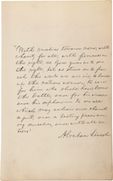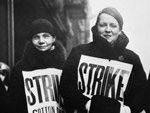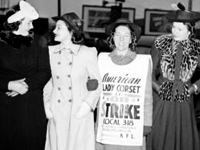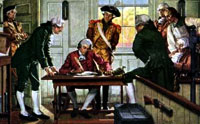Not many Jews immigrated to the United States before about 1820, but the 350th anniversary of Jewish settlement in America was celebrated in 2004 to mark the arrival in New Amsterdam (New York City) in 1654 of a group of two dozen Jewish settlers from the Netherlands, by way of Brazil. Over the next century and more, Jewish immigrants to America came mostly from Spain, Portugal, and the West Indies. They were of Sephardic descent, although a few were Ashkenazim from Germany or England. Jews who settled in the American colonies often made their living by being merchants, land speculators, and importers and exporters, dealing especially in fur, whale oil, candles, wine, rum, cocoa, and textiles. They welcomed the New World's economic opportunities, but also hoped to find in America a refuge from the religious persecution they had experienced in Europe.
Jews were not welcomed everywhere in the colonies, but they established small communities in New York City; Newport, Rhode Island (1695); Charleston, South Carolina (1745); Savannah, Georgia (1735); and Philadelphia, Pennsylvania (1739): Roger Williams had founded Rhode Island on the principle of religious tolerance. English liberal philosopher John Locke had drawn up the Constitutions of Carolina, which were strongly tolerant in matters of religion. Quaker William Penn also welcomed settlers of different religious beliefs into the colony of Pennsylvania, and James Oglethorpe, Georgia's first governor, established a precedent of tolerance when he assisted a group of Jews to settle in the colony, shortly after it was founded, where they opened Congregation Mickva Israel in 1735.
The oldest synagogue building in North America, Touro Synagogue, was opened in Newport in 1763. It is still in use today. Charleston's Kahal Kadosh Beth Elohim was organized in 1749. Its present building, finished in 1794, is the second oldest in the United States and the oldest in continuous use. Until well after the Revolutionary War, the Jewish center of gravity in America was Charleston. Only later did New York City overtake it in influence.
...New England, well into the 19th century, was generally less tolerant of Jewish immigration than other areas in the country...
Early Puritan New England was highly attuned to the traditions and culture of ancient Israel, but saw its own society as the "New Jerusalem," governed by covenantal relationships among its own "chosen people." Ironically, perhaps, this meant that New England, well into the 19th century, was generally less tolerant of Jewish immigration than other areas in the country, and when it was allowed, it was sometimes done because of the Puritan conviction that it would give the Jews the opportunity to be evangelized and converted to Christianity.
On the eve of the American Revolution, between 2,000 and 3,000 Jews lived in the colonies, which had a total population of 3 million. By and large, Jews were sympathetic to the effort to achieve independence from Britain. Especially attractive to Jews, because of their experience in Europe, were American efforts to create a society in which no particular religion would be established by the State. The Enlightenment influence on Revolutionary and early Republican ideals—as in Thomas Jefferson's notion of a "wall of separation between church and state"—greatly appealed to the Jewish community.
The Jewish communities in the cities were temporarily dispersed when many of their members fled British occupation forces. Perhaps 100 Jewish men served as soldiers for the American cause. Many of them were recognized for their distinguished military service. Haym Salomon, a Polish Jew who came to America in 1772, joined the Sons of Liberty in New York and became probably the greatest financier of the Revolution. Francis Salvador, who immigrated from England in 1773, was a prominent colonial legislator and American patriot in Charleston, and was killed in battle in 1776.
Books of Special Interest to Pre-college Students on the History of Jews in Colonial and Revolutionary America
Faber, Eli. "Prologue to American Jewish History: The Jews of America from 16541820," 2346, in From Haven to Home: 350 Years of Jewish Life in America, ed., Michael W. Grunberger. New York: George Braziller. The "coffee table book" published to accompany the exhibit at the Library of Congress in 2004. The exhibit's website is still online (see below).
Malamed, Sandra Cummings. The Jews in Early America: A Chronicle of Good Taste and Good Deeds. McKinleyville, Ca.: Fithian Press, 2003.
Kenvin, Helene Schwartz. This Land of Liberty: A History of America's Jew. West Orange, N.J.: Behrman House, 1986.
Diner, Hasia R. A New Promised Land: A History of Jews in America. Oxford: Oxford University Press, 2003, pages 121.
Websites
A Portion of the People: Three Hundred Years of Southern Jewish Life, University of North Carolina Library.
This exhibit tells "the story of Southern Jewish settlers and their descendants from the late 1600s through the 21st century." It currently consists of two presentations, each with more than 50 pages presenting an image from the exhibit's collection with accompanying explanatory text. Images include portraits, maps, historical documents, photographs of Jewish ritual books and religious and cultural objects, paintings and photographs of synagogues, and photographs of Jewish businesses. "First Families" explores the period from the 1600s to the 1820s through more than 50 images and "This Happy Land" explores the antebellum and Civil War years through more than 90 images. (The presentation Pledging Allegiance, recounting the story of Jewish migration to the South in the first half of the 20th century, is under construction.) Visitors can listen to six interviews featuring voices from the past (transcripts are available). Additionally, a photographic essay with more than 40 photographs, Palmetto Jews by Bill Aron, examines Jewish life in South Carolina over the past 50 years. There is no site search capability.
Jews in America: Our Story, Center for Jewish History.
The history of Jews in America from the 17th century to the present is explored in this website through essays, images, video presentations, and interactive timelines. "It is a portrait of American Jews—and a portrait of America." It presents this story through eight sections focused on particular time periods: 16541776; 1777—1829; 1830—1880; 1881—1919; 1920—1939; 1940—1948; 1949—1967; and 1968—present. Each section has short topical essays explaining the period (an introduction, world events, politics, religion and community, and daily life; some sections add essays on arts and entertainment, sports, or science), video and audio presentation(s), an image gallery, and books for further reading. A number of sections also have "featured artifacts" that examine a particular cultural artifact in greater detail. The timeline has information about the events on the timeline and links to related websites about the event, where available. Each image is accompanied by a description and a larger size image. The 590 images in the collection can also be viewed in a separate gallery. A keyword search is available. This site is of interest to anyone teaching or researching the history of Jews in America, cultural history, ethnicity, or art history.
From Haven to Home: 350 Years of Jewish Life in America, Library of Congress.
An exhibition on Jewish life in America emphasizing the themes of accommodation, assertion, adaptation, and acculturation. The website features more than 200 illustrations, portraits, and images of books and documents from Library of Congress collections. The website offers an explanatory overview of the exhibition and four brief electronic exhibits focused that help to tell a part of the Jewish story in America from 1654 to the present. Some of the items highlighted by the exhibition include the first book printed in the English settlements of America, the Bay Psalm Book printed in 1640, the first published American Jewish sermon, and a hand-drawn plaque from ca. 1942 with dual Hebrew prayers for Winston Churchill and Franklin Roosevelt. A small bibliography lists 10 books plus six books for children. The site provides an introduction to the Library of Congress collections and is useful for teaching about the history of Jewish life in America.
Scholarly Books
Pencak, William. Jews & Gentiles in Early America, 16541800. Ann Arbor: University of Michigan Press, 2005.
Faber, Eli. A Time for Planting: The First Migration 16541820. The Jewish People in America, Volume 1. Baltimore: Johns Hopkins University Press, 1992.
Reiss. Oscar. The Jews in Colonial America. Jefferson, N.C.: McFarland & Company, 2004.
Marcus, Jacob Rader. Early American Jewry. 2 volumes. Philadelphia: Jewish Publication Society of America, 195153.
-----. The Colonial American Jew, 14921776. 3 volumes. Detroit: Wayne State University Press, 1970.
-----. United States Jewry, 17761985. Volume 1. Detroit: Wayne State University Press, 1989.
Sarna, Jonathan. American Judaism: A History. New Haven: Yale University Press, 2004, pages 140.
Hertzburg, Arthur. The Jews in America. New York: Simon and Schuster, 1989, pages 1773.
Sachar, Howard M. A History of the Jews in America. New York: Vintage Books, 1993, pages 937.
Diner, Hasia R. Jews of the United States, 16542000. Berkeley: University of California Press, 2004, pages 1357.





